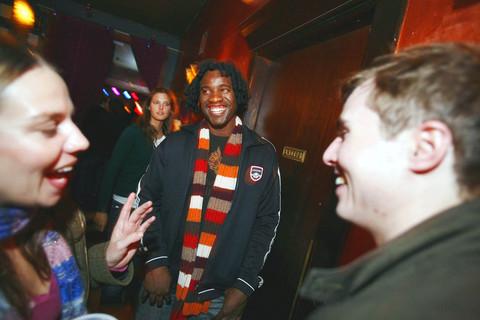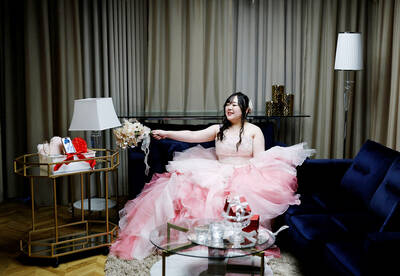When Douglas Martin first saw the video for Nirvana's Smells Like Teen Spirit as a teenager in High Point, North Carolina, "it blew my mind," he said. Like many young people who soothe their angst with the balm of alternative rock, Martin was happy to discover music he enjoyed and a subculture where he belonged.
Except, as it turned out, he didn't really belong, because he is black.
"For a long time, I was laughed at by both black and white people about being the only black person in my school that liked Nirvana and bands like that," said Martin, now 23, who lives in Seattle, where he is recording a folk-rock album.

PHOTO: NY TIMES NEWS SERVICE
But 40 years after black musicians laid down the foundations of rock, then largely left the genre to white artists and fans, some blacks are again looking to reconnect with the rock music scene.
The Internet has made it easier for black fans to find one another, some are adopting rock clothing styles, and a handful of bands with black members have growing followings in colleges and on the alternative or indie radio station circuit. It is not the first time there has been a black presence in modern rock. But some fans and musicians say they feel that a multiethnic rock scene is gathering momentum.
"There's a level of progress in New York in particular," said Daphne Brooks, an associate professor of African-American studies at Princeton. She was heartened last summer by the number of black children in a class she taught at the Willie Mae Rock Camp for Girls, where kids learn to play punk-rock standards.
There is even a new word for black fans of indie rock: "blipster," which was added to UrbanDictionary.com last summer, defined as "a person who is black and also can be stereotyped by appearance, musical taste, and/or social scene as a hipster."
Bahr Brown, an East Harlem resident of New York whose Converse sneakers could be considered blipster attire, opened a skateboard and clothing boutique, Everything Must Go, in the neighborhood in October, to cater to consumers who, like himself, want to dress with the accouterments of indie rock: "young people who wear tight jeans and Vans and skateboard through the projects," he said.
"And all the kids listen to indie rock," he said. "If you ask them what's on their iPod, its Death Cab for Cutie, the Killers."
A 2003 documentary, Afropunk, featured black punk fans and musicians talking about music, race and identity issues, and it has since turned into a movement, said James Spooner, its director. Thousands of black rock fans use Afropunk.com's message boards to discuss bands, commiserate about their outsider status and share tips on how to maintain their frohawk hairstyles.
"They walk outside and they're different," Spooner said of the Web site's regulars. "But they know they can connect with someone who's feeling the same way on the Internet."
On MySpace, the trailer for Spooner's new film, White Lies, Black Sheep, about a young black man in the predominantly white indie-rock scene, has been played upward of 40,000 times.
Nev Brown, a photographer and writer from Brooklyn, New York, said that at the indie rock shows that he has covered for his music blog, FiddleWhileYouBurn.com, he is almost always the only black person in the room. Some fans are curious about why he is at the show and try to talk to him about it.
"And then you get idiots, like people who think you're a security guard," he said.
Damon Locks, a Chicago-based publicist and singer in a hardcore band called the Eternals, said he is frequently mistaken for "one of the other three black guys" in the city's rock-music scene. "We joke about it," he said. "We've been thinking about getting together and starting a band called Black People."
That kind of isolation is one of the reasons Spooner, the documentary director, regularly showcases black and mixed-race rock bands at clubs. For a band to participate, the lead singer must be black. This caused some friction early on, he said. "A lot of white people were offended that I was saying, 'This is for us,"' Spooner said on a recent evening at the Canal Room, a club in downtown Manhattan, where he was the DJ between sets for multiethnic bands like Graykid, Martin Luther and Earl Greyhound.
But, he added: "almost every black artist I know wants to play in front of their people. This is bigger than just rocking out or whatever."
Thomas, of This Moment in Black History, said that white fans sometimes want to know why he is not rapping. "It's the stupidest question," he said.
Just as often, it is blacks who are judgmental. "There's an unfortunate tendency for some black people to think if you listen to rock music or want to play rock music, you're an Uncle Tom," Thomas said.
LaRonda Davis, president of the Black Rock Coalition, an organization co-founded by Vernon Reid of Living Colour in the mid-1980s to advocate for black rock bands, said the resistance is rooted in group-think. "Black people were forced to create a community," she said. "We're so protective and proud of it, like, 'We have to protect our own,' and why should we embrace something that has always excluded us?"
Nelson George, author of Buppies, B-Boys, Baps & Boho's: Notes on Post-Soul Culture, suggested that the rock 'n' roll aesthetic had been a major deterrent. "Black kids do not want to go out with bummy clothes and dirty sneakers," George said. "There is a psychological subtext to that, about being in a culture where you are not valued and so you have to value yourself."
But lately, rock music, and its accouterments, are being considered more stylish. Mainstream hip-hop artists like Lil Jon and Lupe Fiasco rap about skateboarding, and "all of the Southern rap stars are into the '80s punk look, wearing big studded belts and shredded jeans," said Anoma Whittaker, the fashion director of Complex magazine. At the same time, the hip-hop industry's demand for new samples has increased the number of rock songs appearing on hip-hop tracks: Jay-Z's latest album features contributions from Chris Martin of Coldplay and R&B artist Rihanna's current single samples the New Wave band Soft Cell.
"Hip-hop has lost a lot of its originality," said Brown of Everything Must Go, the East Harlem skateboard shop. "This is the new thing."

We lay transfixed under our blankets as the silhouettes of manta rays temporarily eclipsed the moon above us, and flickers of shadow at our feet revealed smaller fish darting in and out of the shelter of the sunken ship. Unwilling to close our eyes against this magnificent spectacle, we continued to watch, oohing and aahing, until the darkness and the exhaustion of the day’s events finally caught up with us and we fell into a deep slumber. Falling asleep under 1.5 million gallons of seawater in relative comfort was undoubtedly the highlight of the weekend, but the rest of the tour

Youngdoung Tenzin is living history of modern Tibet. The Chinese government on Dec. 22 last year sanctioned him along with 19 other Canadians who were associated with the Canada Tibet Committee and the Uighur Rights Advocacy Project. A former political chair of the Canadian Tibetan Association of Ontario and community outreach manager for the Canada Tibet Committee, he is now a lecturer and researcher in Environmental Chemistry at the University of Toronto. “I was born into a nomadic Tibetan family in Tibet,” he says. “I came to India in 1999, when I was 11. I even met [His Holiness] the 14th the Dalai

Music played in a wedding hall in western Japan as Yurina Noguchi, wearing a white gown and tiara, dabbed away tears, taking in the words of her husband-to-be: an AI-generated persona gazing out from a smartphone screen. “At first, Klaus was just someone to talk with, but we gradually became closer,” said the 32-year-old call center operator, referring to the artificial intelligence persona. “I started to have feelings for Klaus. We started dating and after a while he proposed to me. I accepted, and now we’re a couple.” Many in Japan, the birthplace of anime, have shown extreme devotion to fictional characters and

Following the rollercoaster ride of 2025, next year is already shaping up to be dramatic. The ongoing constitutional crises and the nine-in-one local elections are already dominating the landscape. The constitutional crises are the ones to lose sleep over. Though much business is still being conducted, crucial items such as next year’s budget, civil servant pensions and the proposed eight-year NT$1.25 trillion (approx US$40 billion) special defense budget are still being contested. There are, however, two glimmers of hope. One is that the legally contested move by five of the eight grand justices on the Constitutional Court’s ad hoc move